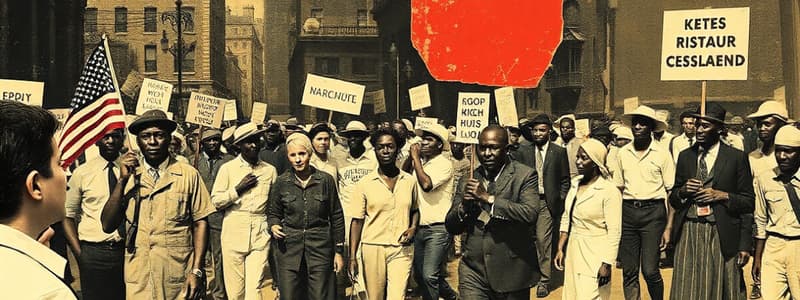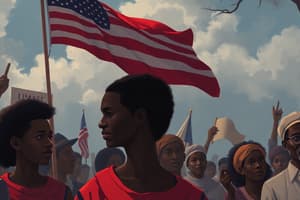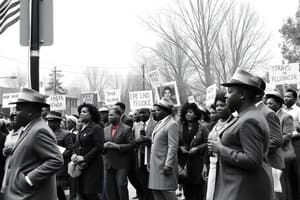Podcast
Questions and Answers
What was the primary goal of the Civil Rights Movement in the 1950s and 1960s?
What was the primary goal of the Civil Rights Movement in the 1950s and 1960s?
- To establish separate but equal facilities.
- To win freedoms and equality for African Americans. (correct)
- To maintain the status quo of racial inequality.
- To promote economic segregation.
The Montgomery Bus Boycott was sparked by Rosa Parks willingly giving up her seat on a bus to a white passenger.
The Montgomery Bus Boycott was sparked by Rosa Parks willingly giving up her seat on a bus to a white passenger.
False (B)
What percentage of the Montgomery public bus system riders were African American?
What percentage of the Montgomery public bus system riders were African American?
75%
The Montgomery Bus Boycott lasted for ______ days, leading to the desegregation of the city's buses.
The Montgomery Bus Boycott lasted for ______ days, leading to the desegregation of the city's buses.
Match the following figures or groups with their corresponding approaches to civil rights:
Match the following figures or groups with their corresponding approaches to civil rights:
Which of the following best describes the purpose of the Jim Crow laws in the late 1800s?
Which of the following best describes the purpose of the Jim Crow laws in the late 1800s?
Following the desegregation of buses in Montgomery, all public facilities and institutions in the city were not immediately integrated.
Following the desegregation of buses in Montgomery, all public facilities and institutions in the city were not immediately integrated.
What was the purpose of the march from Selma to Montgomery?
What was the purpose of the march from Selma to Montgomery?
African Americans were often ______, humiliated, or taunted due to prevailing racist attitudes.
African Americans were often ______, humiliated, or taunted due to prevailing racist attitudes.
What fundamental belief distinguished Malcolm X's approach from that of Martin Luther King Jr. regarding achieving civil rights?
What fundamental belief distinguished Malcolm X's approach from that of Martin Luther King Jr. regarding achieving civil rights?
The Civil Rights Movement did not completely eliminate all forms of racial discrimination in the United States by the end of the 1960s.
The Civil Rights Movement did not completely eliminate all forms of racial discrimination in the United States by the end of the 1960s.
Describe the role African American taxi cab drivers played in the Montgomery bus boycott.
Describe the role African American taxi cab drivers played in the Montgomery bus boycott.
Despite the progress made during the civil rights movement, many African Americans still did not register to vote because of ______.
Despite the progress made during the civil rights movement, many African Americans still did not register to vote because of ______.
In what decade did African Americans secure the right to vote and witness further legislation passed to outlaw discrimination?
In what decade did African Americans secure the right to vote and witness further legislation passed to outlaw discrimination?
Match individuals and organizations with their reaction to the Montgomery Bus Boycott:
Match individuals and organizations with their reaction to the Montgomery Bus Boycott:
Flashcards
Jim Crow Laws
Jim Crow Laws
Laws passed in the South that legalized the separation of people based on race.
Segregation
Segregation
The act of setting someone or something apart from others, often based on race.
Civil Rights Movement
Civil Rights Movement
A movement in the 1950s and 1960s to win freedoms and equality for African Americans.
Boycott
Boycott
Signup and view all the flashcards
Rosa Parks (1955)
Rosa Parks (1955)
Signup and view all the flashcards
Montgomery Bus Boycott
Montgomery Bus Boycott
Signup and view all the flashcards
Martin Luther King Jr.
Martin Luther King Jr.
Signup and view all the flashcards
"I Have a Dream" Speech
"I Have a Dream" Speech
Signup and view all the flashcards
Selma to Montgomery Marches
Selma to Montgomery Marches
Signup and view all the flashcards
Ku Klux Klan (KKK)
Ku Klux Klan (KKK)
Signup and view all the flashcards
Malcolm X Philosophy
Malcolm X Philosophy
Signup and view all the flashcards
Integration
Integration
Signup and view all the flashcards
1968 Riots
1968 Riots
Signup and view all the flashcards
Study Notes
Jim Crow Laws and Segregation
- In the late 1800s, Jim Crow laws in the South legalized segregation.
- African Americans were disallowed from using the same facilities as others.
- They were mandated to use separate drinking fountains and sit at the back of buses.
- Black children were required to attend underfunded all-Black schools instead of the same schools as white children.
- Churches were also segregated.
- African Americans suffered bullying, humiliation, and taunts.
- Many African Americans in the South could not vote.
- Segregation affected the South the most, but discrimination existed in other states.
- Segregation is setting someone or something apart from other people or things.
Civil Rights Movement
- The Civil Rights movement aimed to achieve freedoms and equality for African Americans.
- The movement gained momentum in the 1950s and 1960s.
- African American war veterans were determined to fight discrimination upon returning home.
Rosa Parks and the Montgomery Bus Boycott
- In 1955, Rosa Parks began a "revolution" after sitting in an empty seat in the middle of a bus in Montgomery, Alabama.
- When the bus driver ordered her to give up her seat to a white man, she politely declined.
- The driver had her arrested.
- The African American community responded by boycotting the buses, a move of significant impact as they made up 75% of the bus system's ridership.
- Boycott organizers arranged carpools, and African American taxi drivers offered rides at bus rates, reducing prices.
- Pro-segregation white citizens tried to stop the boycott by firing African American employees and arresting carpoolers on trivial charges.
- Some African Americans even had their homes bombed.
- Despite the opposition, the boycotters stood their ground and refused to ride the buses.
- Segregation on city buses was outlawed 381 days later.
- This Montgomery Bus Boycott was the first major organized protest for civil rights, inspiring civil rights activists throughout the 1950s and 1960s.
- Despite progress, African Americans still were not treated equally.
- Desegregation of the bus system did not extend to schools, restaurants, movie theaters, and bathrooms, which remained segregated.
- Fear of violence prevented many from registering to vote.
- The violent Ku Klux Klan (KKK) remained a powerful force because people feared local law enforcement.
Martin Luther King Jr. Comes to the Forefront
- Martin Luther King Jr., an organizer of the Montgomery Bus Boycott, emerged as a civil rights leader during this period.
- He was respected by both blacks and whites for his eloquence and gentle but firm demeanor.
- King spoke out against the mistreatment of fellow black citizens.
- King's "I have a Dream" speech, advocating for racial equality, is one of the most renowned speeches in American history
Marches and Protests
- The initial 600 protesters grew as 25,000 people marched from Selma, Alabama, to the state capital, Montgomery.
- The National Guard was sent for protection.
- The civil rights movement made progress through the 1960s but remained dangerous to those participating in it.
Malcolm X and Racial Separatism
- New leaders argued that African Americans would never achieve civil rights through non-violent means.
- Malcolm X called on blacks to fight for their freedoms.
- Malcolm X's family was harassed by the KKK during the 1920s.
- While he acknowledged the place of peaceful protest, he advocated for black people to fight back if met with violence.
- He urged African Americans to fight for racial separation.
- Malcolm X supported racial separation and believed African Americans should gain power.
- Malcolm X was assassinated in February 1965; after his death, his views grew in popularity.
Integration and Violent Riots
- Many people wanted integration between the two races.
- Integration can be defined as blacks and whites interacting together in the same neighborhoods, schools, and businesses.
- The mid-to-late 1960s experienced violent riots across the country.
- The suppressed rage had finally boiled over.
- The violence was like a seething river of hatred.
- Demonstrations were not peaceful, and the advocates were willing to use violence.
Racial Division and Assassination
- The nation became two separate races.
- Unrest was constant.
- Martin Luther King Jr. was murdered in 1968.
- Riots broke out nationwide following the assassination.
Civil Rights Victories
- African Americans were able to procure the right to vote in the 1960s.
- Legislation was passed to ban discrimination.
- African-American leaders began to win government positions.
- Gradually, African Americans began to hold positions at local, state, and federal levels.
Studying That Suits You
Use AI to generate personalized quizzes and flashcards to suit your learning preferences.



